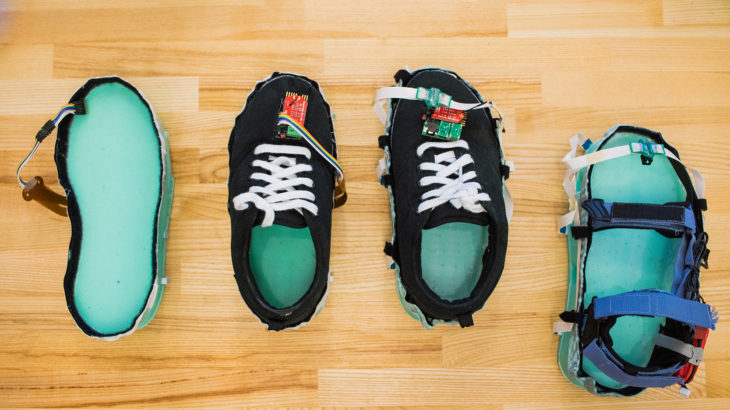For people suffering from Parkinson’s disease, walking can be increasingly difficult as the disease progresses. More than one million Americans live with Parkinson’s disease and suffer a significantly higher risk of falling than other populations. Roboticist and physical therapists at the University of Utah, however, have teamed up to develop a gait therapy using the latest virtual reality (VR) and wearable technology for enriched and realistic experience.
Yue Wang, a mechanical engineering Ph.D. student at the U, led the effort in developing a soft robotic Smart Shoe for an augmenting sensation of virtual terrain in VR. This Smart Shoe is the core device in the VR gait-training system and the center of Wang’s Ph.D. The shoe uses a controlled, durable passive bladder system that allows the sole to deform when stepped on. The embedded miniature valves open and close accordingly to deflate specific bladders for rendering desired terrain features when the user interacts with the virtual world. After years of research and development, the latest version of the Smart Shoe has been optimized in performance and durability. In fact, when the team tested the new reinforced prototype with a robotic foot, it faltered against the strength of the shoe.

Yue Wang
VR has been applied to military and surgical training, as well as interactive gaming, but rehabilitation with terrain rendering had very little research behind it. With the Smart Shoe, users feel as though they are walking on uneven and difficult terrain, all while remaining on a treadmill in a safe and comfortable environment.
“We are making every aspect of our VR system much bigger and better than existing systems: the Smart Shoe is the first fully functional and durable footwear for VR gait training,” Wang said. “Our goal is to apply the Smart Shoe in our VR system to render challenging terrain features so that Parkinson’s disease subjects can practice walking on difficult terrain without worrying about falling. We hope they can regain their normal walking capability to live a regular life again.”
This new technology can do more beyond gait training. Elderly individuals or those who struggle with balance also can benefit from wearing a Smart Shoe as an assistive device. The sole of the shoe can adjust to compensate for uneven terrain that would have previously knocked the wearer off their feet.
So far, Smart Shoe has been tested on healthy individuals but will start testing with Parkinson’s patients in the next month, made possible through a partnership with the physical therapy department at the U.
More articles like this in ‘Student Innovation @ the U!’
Find this article and a lot more in the 2018 “Student Innovation @ the U” report. The publication is presented by the Lassonde Entrepreneur Institute to celebrate student innovators, change-makers and entrepreneurs.





Hello! Are these shoes available for use or testing? I have Parkinson’s and one of my biggest challenges is gait and balance . I would enjoy the opportunity to try these
Hi Carl. Possibly. We’ll alert the student engineer and ask him to contact you.
Hey Carl, thanks for your interest in our project! We are currently conducting PD gait training study in a VR system and will be integrating the Smart Shoes for PD training very soon! Please keep in contact with us!
I am a Parkinson’s patient. diagnosed in 2003. I received a deep brain stimulator (dbs) in 2013. My gate is my greatest challenge to safe navigation. I would welcome being considered to participate in any studies you are conducting. I have some familiarity with VR applications and human response thresholds and measurements. I have spent the last 30+ years in the simulation and training industry.
Thanks for contacting us. We’ll forward your message to the researchers.